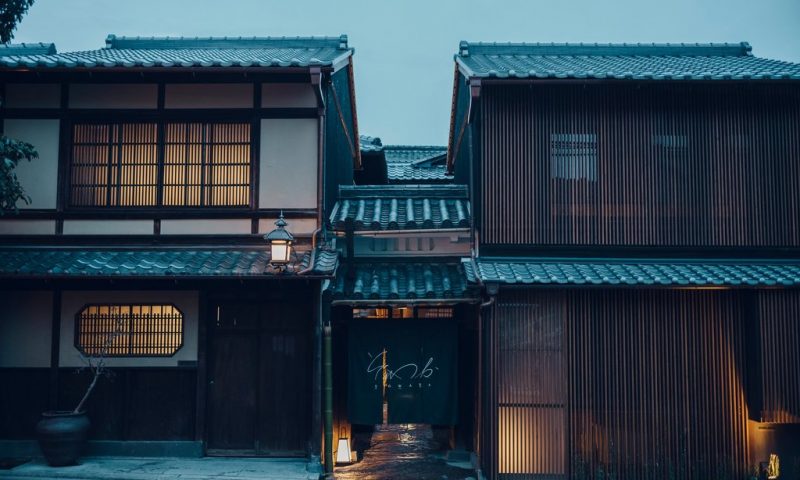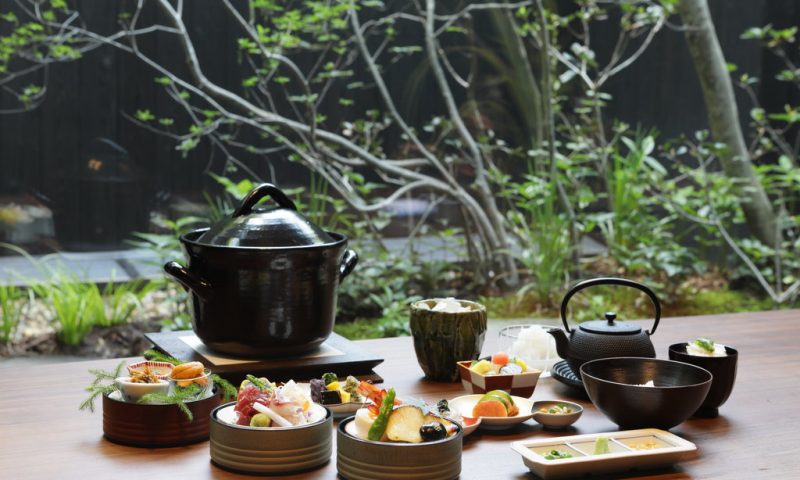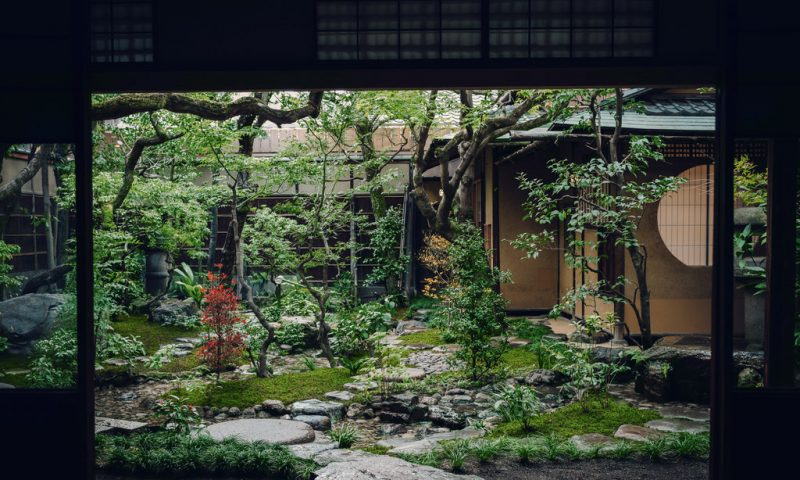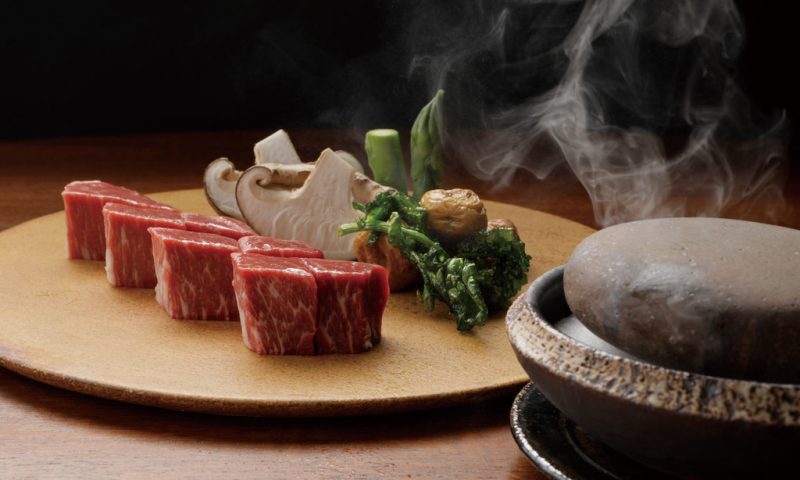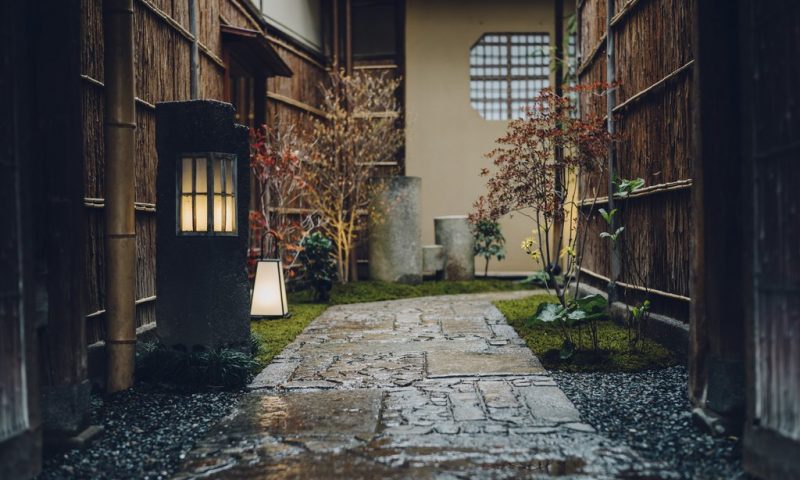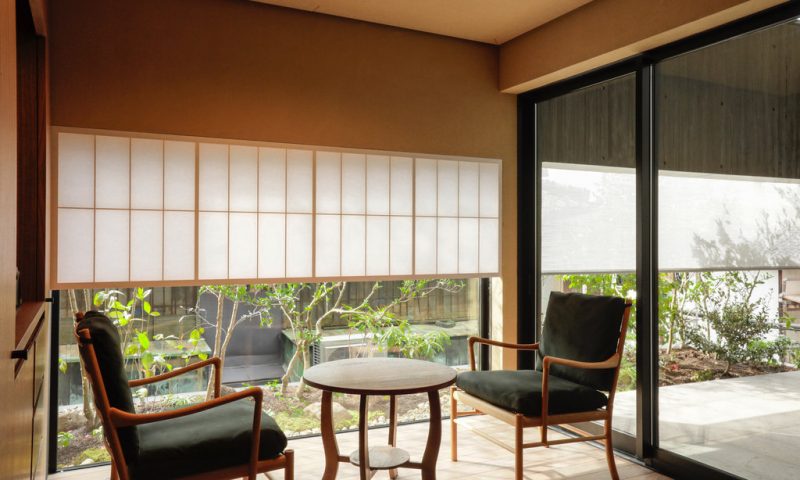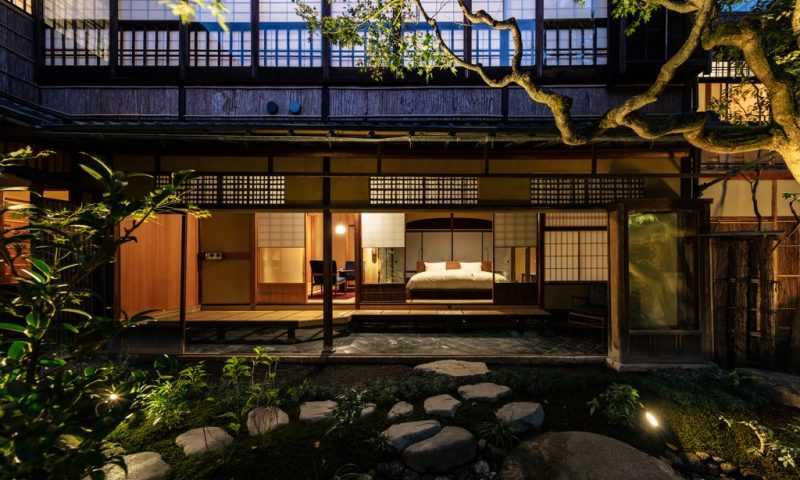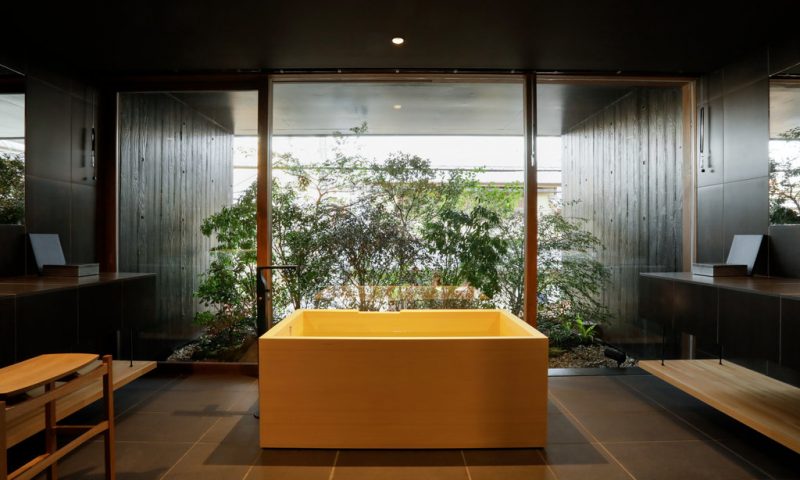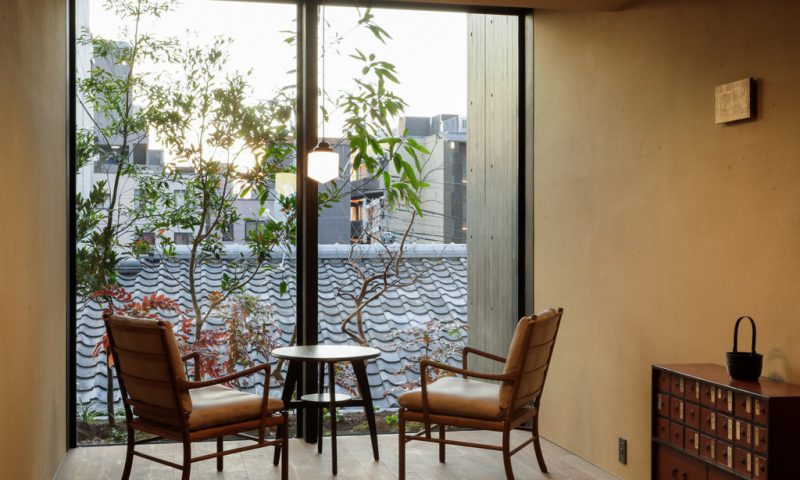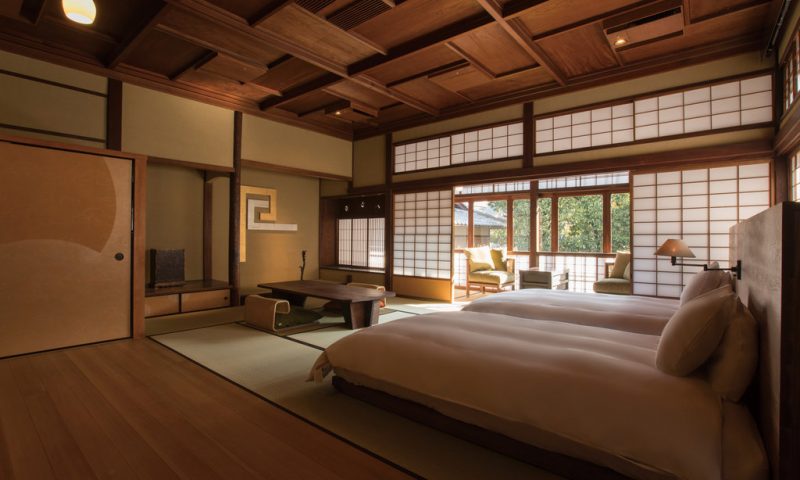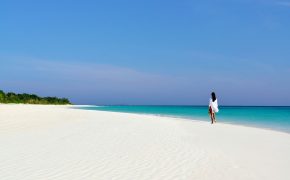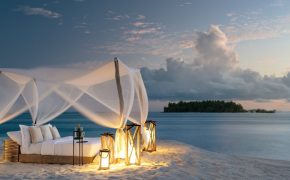Sowaka is a Sanskrit word meaning “happiness” or “wellbeing.” It is a word of blessing, often spoken at the end of the Buddhist sutras that echo through the innumerable temples of Kyoto.
Once across the stone threshold, you are instantly transported to an oasis of calm. Relax in one of Sowaka’s 23 individually designed rooms, listening to gentle breezes blow through the green and tranquil courtyard. Situated in the charming neighborhood of Gion and Yasaka, the hotel effuses ethereal elegance in its luxurious space combining nostalgia with modernity.
Enjoy creative, distinctive Kyoto cuisine at La BOMBANCE Gion, the latest outpost of the award-winning Tokyo restaurant. Meanwhile the ancient streets and charming neighborhoods of Kyoto are just outside your door. “Sowaka” represents the very best wishes to our beloved guests. May you enjoy an abundance of blessings.
ACCOMMODATION
The main building, formerly a traditional Japanese restaurant, follows the Sukiya architectural style that dates back a hundred years. The Annex, which adjoins it, was built to complement the main building’s original design using the best modern architectural and construction techniques.
What both of these spaces have in common is the spirit of “suki” (“refined taste”). “Suki” brings to mind traditions such as the tea ceremony, but the origin of the phrase is “to like.” The Sukiya architectural style is meant to please guests with its playful, unconventional approach, based on the designs of traditional Japanese tea ceremony rooms.
Accordingly, each of Sowaka’s spacious guestrooms has its own charm. The main building offers rooms with a distinctively Japanese “suki” spirit, inherited from past generations, while the annex rooms bring the concept of “suki” into the modern age.
MAIN BUILDING
The main building was constructed in the sukiya architectural style as a Japanese-style restaurant between the end of the Taisho Period and around the beginning of the Showa Period. The design details differ from room to room, creating a sophisticated building showcasing superb craftsmanship and playfulness.
Based on the original structure and details,the eleven pleasantly arranged guestrooms come in a wide variety,including rooms with a private garden and maisonnette-type rooms. Our guests can savor the distinctive charm of each individual room.
GARDEN VIEW SUITE
This suite was formerly called the “Horagaino-ma” (“Conch Shell Room”), in reference to the vivid design of the conch shell-shaped door handles. Opening the sliding door, you can find yourself in an open and luxurious bedroom surrounded by the traditional clay walls skillfully finished with a delicate touch. The room boasts the beautifully serene view of the main garden, Sowaka’s heartful pride.
LA BOMBANCE GION
The restaurant La Bombance Gion is located on the first floor of the Annex. It is overseen by the award-winning La Bombance restaurant in Nishi-azabu, Tokyo, which has held a Michelin star for ten consecutive years starting in 2008.
La Bombance Gion uses locally sourced ingredients to create a seasonal menu that changes monthly, featuring dishes that are an elegant, imaginative reinterpretation of traditional Japanese cuisine. The restaurant is reserved for SOWAKA guests only during breakfast, and is open to the general public for lunch and dinner.
DIETARY RESTRICTIONS
We at La Bombance Gion wish for all of our customers to enjoy our food to the greatest extent possible and ask in advance whether there are any allergies or religious or other dietary restrictions that need to be taken into consideration.
If there are any ingredients that you cannot eat or are allergic to, please let us know in advance. We will respond to your needs to the greatest extent possible, but please keep in mind that since ingredients must be purchased in advance, giving us one week’s notice will allow us to provide you with dishes tailored to suit your needs.
We apologize for any inconvenience this may cause, but we will do everything possible to ensure that your experience here at La Bombance Gion is a satisfying one. Thank you for your understanding and cooperation.
BREAKFAST
Two types of breakfast are available at Sowaka: Japanese and Western, both prepared with fresh Japanese dashi-soup. Japanese style features handmade tofu, a warm omelet, and Saikyo style grilled fish, served with rice, miso soup and plenty of seasonal vegetables. Western style features scrambled eggs, grilled vegetables, sausages, soup, yogurt and handmade fresh juice.
LUNCH
Lunch at La Bombance offers a relaxed and casual menu, prepared using the same ingredients, and with the same skill, as the restaurant’s elegant dinner service. From a hearty tuna bowl to beef sukiyaki, guests are sure to enjoy a satisfying meal.
DINNER
La Bombance proudly presents authentic Japanese cuisine with a modern touch of flavors. The monthly menu utilizes fresh local seasonal ingredients; just like La Bombance in Nishi-azabu, the chef prepares each dish with a story to tell, creating long lasting memories for our guests. Our menu offers both a set course and à la carte dishes.
THE CHEF – MAKOTO OKAMOTO
Born 1973 in Niigata Prefecture. Having worked at one of Japan’s most famous restaurants, Tokyo’s Kioicho Fukudaya, Mr. Okamoto opened the original La Bombance in 2004 which was immediately recognized for its innovative approach to Japanese cuisine.
He has received a Michelin star for 10 consecutive years beginning in 2008. In 2016, Mr. Okamoto opened La Bombance Hong Kong, and La Bombance Gion, in Kyoto’s Sowaka luxury ryokan, in 2019.
TAILORED EXPERIENCES
Specially tailored tours of some of Kyoto’s most unique attractions make for a truly memorable stay Sowaka provides guests with various exclusive opportunities to experience Kyoto and enjoy their stay, including tours of shrines and temples that are not usually open to the public, as well as hands-on cultural experiences.
ZAZEN MEDITATION
“Zazen” — literally “sitting meditation” in Japanese — is a form of meditation practiced by Zen Buddhist monks and priests. While its history goes back millennia, “Zazen” found a foothold in Kyoto in the early 13th century.
In collaboration with “Kanza Kyoto”, an organization led by monks from Kyoto, you can experience “Zazen” in your room at SOWAKA. In a world full of entangled information and emotions, slow down in our quiet little corner of Gion and find pure peace of mind.
THE KYOTO CUISINE
Kyoto is also synonymous with the word “Maiko”. Anyone can have the experience of spending time with maiko by taking part in “An Evening of Kyoto Cuisine with Maiko”, a dinner event held at Gion Hatanaka.
Sowaka can arrange attendance for its overnight guests at this event as well. This incredible experience that includes a maiko dance performance and parlor games with maiko will surely create lasting memories of your travels in Kyoto.
LOBBY LOUNGE
Upon arriving at Sowaka, please make yourself at home here while we take care of your luggage and serve you a welcome drink. Relax in the lounge’s luxurious, comfortable seating, examine the many unique features that have been preserved from the original antique building or browse its carefully curated library of books about sukiya, which we invite you to peruse during your stay.
BAR
This intimate space just off the reception area was designed by Kyoto master craftsman Sotoji Nakamura. The drinks menu emphasizes local ingredients, including sake, shochu and whiskey distilled in Japan. The private setting, seating only four guests, is also a good place to relax and read during the day.
ROOF BALCONY
The rooftop balcony of Sowaka’s main building presents a wonderful view of Higashiyama and the town of Kyoto beneath a vast open sky. During the summer, feel free to relax in the cool of the evening breeze with a beer in hand, while viewing Kyoto’s Gozan Okuribi (Mountain Bonfire) festival, or the Buddhist lantern festival. The roof balcony is also where we host seasonal themed events exclusively for hotel guests.
SPA & WELLNESS
Refresh both your body and mind with our superb lineup of spa treatments. Our Oil Treatment uses the finest organic jojoba oil as well as a fulvic acid extract that contains 26 types of amino acids, 39 minerals, vitamins, and more.
The mineral supplement and detoxing effect help to alleviate stiff shoulders and swelling. The Face Pack is a gentle massage given with plenty of beauty essence. This treatment will leave your skin in exceptional condition and your mind and body feeling refreshed.
The Massage and Stretch treatment is recommended for those with built-up fatigue. Our skilled therapists provide both gentle stimulation and deep treatment for relaxation down to the core of your body.
KIMONO RENTAL & FITTING
There is a story behind each and every one of Sowaka’s rental kimonos. For example, the mysterious dyeing style known as Tsujigahana, kosode (short-sleeved kimono) that hearkens back to the Azuchi-Momoyama Period (1568-1600), Kyo-Yuzen that adds extravagance to any setting, and Edo-Komon in an Ameiri-Mansuji pattern with its modern, poetic air.
Wearing one of these kimonos gives you a direct experience with traditional Japanese culture. The next question is where to go in your kimono. Each kimono is carefully chosen to match with the occasion and formality of the wearer’s destination.
This means you can wear a perfectly suited kimono with confidence to any occasion, whether it’s to watch Noh or Kabuki theater, a tea ceremony, or dinner at a top-class restaurant. English-language support is available from the time of fitting.
CHAJI TEA CEREMONY
Participate in an authentic “chaji” tea ceremony that takes place in a tranquil tearoom. Chaji is the most highly valued form of hospitality by tea ceremony masters. From Sumitemae (initial charcoal setting) to Chakaiseki (multi-course meal), Koicha (thick tea), and Usucha (thin tea), the tea master of the Yabunouchi school of tea ceremony for samurai families will guide you through this experience.
You can feel the compassion in each and every step of the ceremony as you come to know and understand the true nature of tea. The whole experience lasts for two and a half hours. The beautiful moments you experience in this small teahouse will fill your heart with joy.
The chaji tea ceremony is typically done only among people with very close personal relationships, so it is a very rare thing to experience even for people who have spent a long time in Japan. This experience is highly recommended. English and Chinese language support are also available.
ELEMENTS OF KYOTO
Sowaka’s furnishings and amenities highlight the very best of local Kyoto craftsmanship. Sowaka’s guest rooms are decorated with carefully selected furniture, fixtures and amenities, all of which are closely connected to Kyoto. These unique furnishings naturally complement the traditional design of your room, helping turn your stay into an immersive, luxurious experience.
NATURAL WOOL MATTRESS
It has been Iwata’s sole purpose to provide comfortable bedding since its establishment as a futon shop in Kyoto’s Sanjo district in 1830. Our guest rooms feature Iwata’s “Larkowl” high-performance mattresses.
These mattresses are made with high-grade natural wool such as cashmere and camel hair, and do not bounce or squeak like spring mattresses or accumulate odors like urethane mattresses. Densely cushioned, with just the right amount of support, Iwata mattresses make for a comfortable, restful night’s sleep.
KITAYAMA CEDAR
These uniquely shaped Bluetooth speakers are made locally by Kyoto Natural Factory out of Kitayama cedar, grown in the northern part of Kyoto. This dense, sturdy wood has long been prized as a traditional building material, particularly for making alcove posts in tea ceremony rooms and Japanese-style houses.
The cedar logs are carefully hollowed into cylinders to form the speaker body. Each speaker is masterfully handmade by the craftsmen of Kyoto. We hope you enjoy their warm tone, produced by all-natural Japanese wood.
BATH AMENITIES FROM KAZURASEI SHINISE
Our bath amenities, including soaps, shampoos and skin care products, are all from the long-established Kazurasei Shinise shop, which has been selling beauty products and hair accessories since 1861.
Camellia oil has long been used as a beauty treatment in Japan. This pure oil, rich in nourishing vitamins, gently moistens the hair and skin. Kazurasei Shinise’s hair care and skin care products are made with 100% organic camellia oil extracted by the shop’s unique manufacturing method.
UNDERGROUND WATER
Surrounded on three sides by mountains, the valley in which Kyoto sits contains an abundance of pure, clean water. Our hotel uses that natural water drawn directly from the ground beneath our site. Having benefited from this water for ages, the people of Kyoto have made it part of the culture.
In many legends, the waters of Kyoto are said to possess spiritual power, including the Otowa-no-taki waterfall of Kiyomizu Temple and the sacred Gion water of Yasaka Shrine, both of which are located near the hotel. This soft underground water, which has extremely low levels of calcifying ions, is distinguished for its delicate feel on the skin and its pure, smooth taste.
VISIT TO KIYOMIZU-DERA TEMPLE
Take a special tour of this UNESCO World Heritage Site, guided by one of the priests of the temple, and get exclusive access to areas that are normally off-limits to the public, including the Sange on the Footprints of the Buddha, the inner shrine of the main temple building, and the temple’s famous Jojuin Moon Garden. Take a step back from the worries and cares of modern life to find serenity among these centuries-old sites.
NIGHT VISIT TO KODAIJI TEMPLE
Kita-no-Mandokoro, the wife of Toyotomi Hideyoshi, the legendary 16th-century Imperial Regent of Japan, built Kodaiji Temple as a place to pray for the repose of her husband’s soul after his death.
Many people visit this temple every year to witness the weeping cherry tree rising up from the Hojo Garden, or the splendor of the red autumn leaves reflecting in Garyochi Pond when the temple is lit up in the fall. Sowaka reserves Kodaiji Temple at night specially for its guests. Amid the silence, enjoy this luxurious experience set in a space rich with history and culture.
GARDEN TOUR
It is Sowaka’s intention to enable our guests to experience “the real thing,” including the craftsmanship of the craftsmen involved and Japanese cultural tradition. One way for us to provide guests with this experience is by arranging garden tours led by a gardener of Ueyakato Landscape Co., Ltd., who takes care of the garden and planting at Sowaka’s main building.
At the core of authentic Japanese culture and tradition, including the tea ceremony and flower ceremony, is the heart of the Japanese people who revere and cherish nature. How did our predecessors perceive and confront nature? This tour provides a look at the aesthetic sense of the Japanese people as seen in a Japanese garden, from the perspective of a gardener.
We arrange programs for our guests to experience the gardens at the temples Nanzenji, Murinan and Chishakuin, maintained by Ueyakato Landscape Co., Ltd., and even gardens that are not usually open to the public, at the best times to see them during each of the four seasons.
BICYCLE RENTAL
Hop on a bicycle and take a cruise around Kyoto as if you lived there. The city is compact and has lots of things to see; it’s like a treasure chest of a city. Bicycles are the perfect way to get around town. The Gion District where Sowaka is located lies in the heart of Kyoto. This makes it an ideal starting point for anywhere you want to go.
From historical spots, temples, and shrines to cafes and used bookstores, pedaling your bike through the breeze of this ancient capital is a great way to become familiar with both the old and new aspects of Kyoto.
SUNRISE VISIT TO KIYOMIZU-DERA TEMPLE
The striking Kiyomizu-dera Temple attracts more visitors than any other sightseeing spot in Kyoto. Avoid the crowds with a special visit to this UNESCO World Heritage Site before breakfast, as the lights begins to touch the rooftops of Higashiyama and the wind murmurs in the trees of Mt. Kiyomizu.
The silent precincts of the temple provide the perfect escape from the daily hustle and bustle, and make for a blissful start to your day.
WALKING AROUND SOWAKA
Sowaka is located in Higashiyama, which, with so many famous sites, is the best area for walking around Kyoto. Ishibekoji, Nenenomichi, Ninenzaka and Sanneizaka, whose townscape is strictly preserved and maintained by Kyoto City law as a historic building preservation district, have many must-see sights that you can enjoy while just walking around.
Recommended is the walking course to Maruyama Park and Chion-in Temple by way of Ishibekoji to Nenenomichi. Beyond the stone-paved street of distinctive ambience are buildings you can enjoy while walking around, including Gionkaku of Daiun-in Temple, which can be seen from Sowaka, and Chourakukan, whose classic Renaissance exterior produces an elegant atmosphere.
DISCOVER THE SPIRIT OF KYOTO
Experience the hustle and bustle of Japan’s ancient capital, with its historic shrines and temples and alleyways overflowing with charm. Sowaka is located in Gion Higashiyama, a popular area that embodies the essence of Kyoto elegance. Here is an introduction to some of the most popular nearby attractions.
HANAMIKOJI-DORI & SHIRAKAWA-DORI STREET
Hanamikoji-dori Street is the center of Gion Kobu, one of Kyoto’s five hanamachi, or geisha districts, and is a splendid location for a late night walk. This street is quiet late at night, making the daytime noises seem like a distant memory, and occasionally you will see maiko (geisha in training) passing by.
Shirakawa-dori, north of the hotel, is one of the city’s most beautifully preserved streets and is also a splendid experience. There you can listen to the comforting murmur of the river as you watch the reflections of the willow trees dance across the surface.
YASAKA-JINJA SHRINE
Steps from Sowaka is the Yasaka shrine, one of Kyoto’s most important temples. It is the center of the famous Gion Festival, held every July, which features a grand procession of floats through the streets of the city.
Besides the Gion Festival, there are other festivals held here each month, including Hatsuzakura Noh (Noh for the first cherry blossoms of the year), the Tanabata Star Festival and the Moon Viewing Festival, all of which are popular among the local people of Kyoto.
KENNINJI TEMPLE
Popularly known as “Kennen-san,” this Zen temple and its grounds are open 24 hours a day, allowing local people to pass through at any time. Meditating on a summer morning is particularly refreshing, both physically and mentally, and is an excellent way to recharge after a night out in Gion.
FUSHIMI INARI-TAISHA
Take a visit to Fushimi Inari-taisha, the main shrine to Inari, the Shinto god of rice. The temple is legendary for its thousands of vermillion torii gates, which line its hillside paths. It is an exceptional place to capture breathtaking pictures.
The word for vermillion in Japanese, ake, can mean both “red” and “light” – that is to say, the color symbolizes bright hope, and also represents the power of life, earth, and birth, which are all presided over by Inari.
